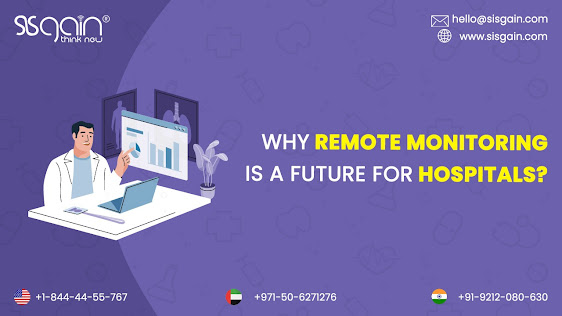Customizing Remote Patient Monitoring Software for Different Healthcare Providers
Introduction :
In the evolving landscape of healthcare, technology plays a vital role in improving patient outcomes and streamlining healthcare delivery. One such technology is remote patient monitoring (RPM) software, which enables healthcare providers to monitor patients' vital signs and health data remotely. However, not all healthcare providers have the same needs or workflows. Customization of RPM software is essential to ensure it aligns with the unique requirements of different healthcare providers. In this blog, we will explore the importance of customizing remote patient monitoring software and highlight key considerations for tailoring it to diverse healthcare settings.
Remote patient monitoring software offers numerous benefits, including enhanced patient care, early intervention, and reduced hospital readmissions. However, these advantages can only be fully realized when the software is customized to fit the specific needs of different healthcare providers. Customization allows healthcare organizations to:
a. Tailor User Interfaces: User interfaces should be intuitive and user-friendly to ensure seamless adoption and utilization by healthcare professionals. Customization allows for the adaptation of interfaces to match the workflow and preferences of specific providers.
b. Define Relevant Parameters: Different healthcare providers focus on varying parameters and metrics when monitoring patients remotely. Customization allows providers to define and prioritize the relevant parameters according to their specialization, ensuring accurate and actionable data.
c. Integrate with Existing Systems: Seamless integration with existing healthcare systems, such as electronic health records (EHRs) and patient management systems, is crucial. Customization enables the alignment of RPM software with existing infrastructure, avoiding duplication of efforts and improving efficiency.
Key Considerations for Customization :
When customizing remote patient monitoring software for different healthcare providers, several considerations come into play. These considerations include:
a. Workflow Integration: Understanding the existing workflow of healthcare providers is essential to ensure the smooth integration of RPM software. Customization should focus on minimizing disruptions and enhancing the efficiency of clinical processes.
b. Device Compatibility: RPM software should be compatible with a wide range of monitoring devices to accommodate the diverse needs of healthcare providers. Customization should include the ability to integrate various monitoring devices, enabling flexibility and scalability.
c. Alert and Notification Settings: Customizing alert and notification settings is crucial to match the urgency and severity levels preferred by different healthcare providers. This allows for timely interventions and ensures appropriate prioritization of patient care.
d. Data Analytics and Reporting: Healthcare providers have unique reporting requirements and data analytics preferences. Customization should include the ability to generate customized reports and analyze data according to specific metrics, facilitating informed decision-making.
Case Studies: Customization in Action :
Let's explore a few examples of how customization can enhance the effectiveness of remote patient monitoring software for different healthcare providers:
a. Hospital Setting: In a hospital setting, where multiple departments and healthcare professionals are involved in patient care, customization can provide role-based access to relevant patient data. Physicians can prioritize specific parameters, nurses can set up alerts for critical readings, and administrators can generate reports based on departmental requirements.
b. Home Healthcare Providers: Customization plays a vital role in remote patient monitoring for home healthcare providers. These providers often need simplified user interfaces for patients and their caregivers, making it easier to navigate and understand the data. Customization can include tailored instructions, reminders, and patient education materials.
c. Specialized Clinics: Remote patient monitoring software can be customized to cater to the specific needs of specialized clinics. For instance, a cardiology clinic may prioritize monitoring blood pressure, heart rate, and ECG data, while a respiratory clinic may focus on oxygen saturation and pulmonary function. Customization ensures the software aligns with the specialized requirements of these clinics.
Implementation and Training :
Effective implementation and training are crucial for the successful customization of remote patient monitoring software. Here are some key considerations:
a. Collaborative Approach: Collaboration between the healthcare provider and the software vendor is essential during the customization process. This ensures that the software meets the specific needs and goals of the provider. Regular communication and feedback loops facilitate a tailored solution.
b. User Training: Customized software requires adequate training to ensure healthcare professionals can effectively utilize its features. Training programs should be designed to familiarize users with the customized interface, data analytics tools, and alert/notification settings. Ongoing support and refresher training should also be provided.
c. Testing and Piloting: Before full deployment, it is essential to conduct thorough testing and piloting of the customized software. This allows for identifying and addressing any issues or gaps in functionality. Feedback from users during the testing phase can further refine and optimize the customization.
d. Scalability and Future Growth: Customization should not hinder the scalability or future growth of the healthcare provider. The software should have the flexibility to accommodate additional features, integration with emerging technologies, and changes in workflows as the organization evolves.
Conclusion :
Customizing remote patient monitoring software is imperative to meet the diverse needs of different healthcare providers. It enables seamless integration, improves user experience, and enhances patient care. By tailoring user interfaces, defining relevant parameters, and integrating with existing systems, healthcare providers can optimize the effectiveness of remote patient monitoring. Real-world examples illustrate how customization can be applied in various healthcare settings. However, successful implementation and training are equally important to ensure that healthcare professionals can make the most of the customized software. As technology continues to advance, customization will continue to play a vital role in driving innovation and improving patient outcomes in remote patient monitoring.


